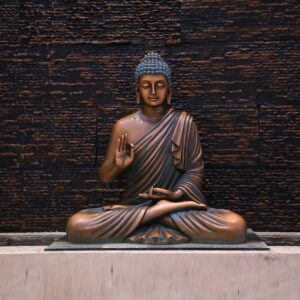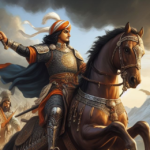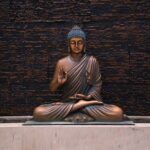Biography
Gautam Buddha was born in Lumbini near Kapilvastu in Nepal. His father’s name was Suddhodan and mother’s name was Mayadevi or Mahamaya. Suddhodan was the Chief of Shakya Clan and Mahamaya was the daughter of Koliyan Dynasty. Soon after the birth of Gautam Buddha his mother was passed away. Gautami Parjapati had brought up Gautam Buddha after his mother’s death. His childhood name was Siddarth. He is also known as Sakhyamuni as he belongs to Sakhya Clan.

He married Yashodhara at the age of 16. One day when he was roaming outside he see a old man, a sick people, a deceased and a saint. Then he left his wife Yasodhara and son Rahul , while they were sleeping in search of Enlightment. When he left his family he is of 29 years.On the way he me with Acharya of Sakya Clan Alam Ara in Vaishali. From there he moves towards Rajgrih and met another Darmacharya Rudrak Ramputt. At the age of 35 Gautam Buddha got enlightment in Bodh Gaya under Bodhi Tree.
After getting enlightment Gautam Buddha decided to preaching his knowledge. From Urvavela ( Bodh Gaya) he reached Sarnath and gave his first sermon to five Brahmin. The first sermon is called Dharmachakraparivartan. From Sarnath he reached Rajgriha and spent his second, third and fourth rainy season. Bimbisara the king of Magadh Empire at that time built a Mahavihara called Velan for his residence.
In the fifth year he reached Vaishali, the capital of Lichavis. Lichhavians build Kutagrahsal in Mahavan for his residence. In Vaishali he met with Amrapali. Amrapali gifted her amravatika to Buddhist monks for residence. In eighth year after getting enlightment Gautam Buddha allowed women to join Buddhist Sangh on the recommendation of his beloved disciple Anand. Gautam Buddha’s aunt Gautami Prajapati became the first women to join the Buddhist Sanga.
Devdatta was the cousin of Gautam Buddha. First he become disciple of Gautam Buddha. Later he wanted to remove Gautam Buddha from the chief position of Buddha Sangha and wanted to get the chief position. But Devdatta not succeeded.
Anantpitaka a rich businessman from Khosala Kingdom donated his Jetavan Vihara for the residence of Buddhist Sangh. Khosala King Prasenjit adopted Buddhism religion along with his family and built Pubbram (Pura-ram) Vihara for Buddhist Sanga.
Gautam Buddha spent his last rainy season in Vaishali. In Pava he met with a blacksmith named Chund. Gautam Buddha stayed in the Amravatika of Chund . Chund offer Gautam Buddha to eat Shukkarmadva’s fruit. After eating this fruit Gautam Buddha Start bleeding. Then he went to Khusinagar/Kusinara and delivered his last sermon to Subadh. Gautam Buddha’s health continuously deteriorating and died at the age of 80 in 483 BC. This event is called Mahavinisikaran.
Buddha’s first sermon in Sarnath is known as Dharmachakraparivartan. This sermon is related to suffering, the cause of suffering and the solution of suffering.
Eight Fold Path of Gautam Buddha
1.Right Understanding (Samma Ditthi)
- Developing a clear know – how of the Four Noble Truths and the nature of existence.
- Recognizing the impermanence and interconnectedness of all phenomena
2. Right Intention (Samma Sankapp)
- Cultivating healthy intentions rooted in compassion, kindness, and renunciation
- Letting go of harmful desires and cultivating intentions that cause leberation.
- Cultivating healthy intentions rooted in compassion, kindness, and renunciation.
- Letting go of harmful desires and cultivating intentions that cause liberation.
- Cultivating healthy intentions rooted in compassion, kindness, and renunciation.
- Letting go of harmful desires and cultivating intentions that cause liberation.
3. Right Speech (Samma Vaca)
- Abstaining from fake, divisive, harsh, or idle speech.
- Speaking surely, kindly, and meaningfully to foster harmony and information.
4. Right Action (Samma Kammanta)
- Engaging in moves which can be ethical and beneficial.
- Abstaining from harming dwelling beings, stealing, and tasty in sexual misconduct.
5. *Right Livelihood (Samma Ajiva)
- Choosing an profession or livelihood this is moral and does not harm others.
- Avoiding professions that involve dishonesty, exploitation, or harming living beings.
6. Right Effort (Samma Vayama):
- Exerting effort to domesticate healthful features and abandon unwholesome ones.
- Persistently working towards mindfulness and intellectual area to conquer poor tendencies.
7. Right Mindfulness (Samma Sati):
- Cultivating consciousness and attentiveness to the prevailing second with out judgment.
- Observing the body, feelings, thoughts, and phenomena with clarity and equanimity.
8. Right Concentration (Samma Samadhi):
- Cultivating deep awareness and mental balance via practices inclusive of meditation.
- Developing a centered and tranquil mind to gain insight into the nature of reality and achieve liberation.
These 8 aspects of the route are interconnected and collectively supportive, guiding practitioners closer to the cessation of suffering and the attainment of enlightenment.The eight fold path is also known as “Arya Satya”. Buddha spread his message in simple and local language. Buddhism didn’t promote castism. The non-Brahmin, especially Dalits were attracted by the simplicity and straight forwardness of Buddhism. Hence like the missionary ideas
Buddhist Council
First Buddhist Council
The First Buddhist Council or Sangiti (in pali) was held in Rajgriha , under the patronage of Magadh King Ajatsatru. It was held after the Death of Gautam Buddha in around 483 B.C. The objective of the council is to preserve and spread Buddha’s teaching. The council was attended by 500 arhat (disciple of Buddha) led by Mahakashyap. The teaching was recited by Anand. Anand spent many years with Buddha as attendant. The teaching has three categories : the Suttas (discourses), Vinaya (monastic rules) and Abhidhamma (philosophical analysis)

Second Buddhist Council
The Second Buddhist Council passed off round a century after the passing of Buddha, approximately in the 4th century BCE. It happened at Vaisali, a town in historical India, under the patronage of King Kalasoka. The council was attended by seven hundred monks with the help of Yasa and Sabbakami The council led to a department inside the Sangha (monastic community) into sects: the Mahasanghika and the Sthaviravada. The Mahasanghika sect believed in liberal interpretations and variations of the Buddhist teachings, whilst the Sthaviravada sect upheld stricter adherence to the unique teachings.
Third Buddhist council
The Third Buddhist Council took place for the duration of the reign of Emperor Ashoka, approximately around the third century BCE, in Pataliputra (modern-day-day Patna), India. It changed into convened commonly to address doctrinal disputes that had emerged in the Buddhist network.Emperor Ashoka subsidized the council, and it became presided over by the venerable monk Moggaliputta Tissa, who was appointed by way of Ashoka. Moggaliputta Tissa compiled a comprehensive precis of the Buddha’s teachings, known as the Kathavatthu, to refute wrong interpretations and maintain the purity of the Dharma.
Fourth Buddhist Council
The fourth Buddhist council was held in Kashmir under the patronage of Kaniska. After the fourth Buddhist council the sects was divided into Hinyana and Mahayana. In Mahayana Gautam Buddha was treated as god and the followers worshiped Gautam Buddha through idols whereas Hinyana treated Gautam Buddha as Great Man.
Sravastivada
The word Sarvāstivāda mean “the Principle of all that exists”. Buddhist faculties set up Sravastivada school within the reign of Emperor Ashoka inside the third century BCE.
The Sarvāstivāda faculty became mainly recognized as an Abhidharma way of life, with a unique set of seven canonical Abhidharma texts. They were one of the most influential Buddhist monastic businesses, flourishing in the course of North India, in particular in Kashmir and Central Asia, until the 7th century CE.
The orthodox department of the faculty in Kashmir composed the big and encyclopedic Abhidharma Mahāvibhāṣa Śāstra for the duration of the reign of Kanishka (c. 127–150 CE). Those who upheld the doctrines within the Mahāvibhāṣa had been known as Vaibhāṣikas.
The Sarvāstivādins are believed to have given upward push to the Mūlasarvāstivāda and Sautrāntika faculties, even though the exact dating between those businesses has no longer been fully decided. The Sarvāstivāda school’s emphasis on causation, conditionality, and the use of rational argument and syllogism turned into big within the development of Buddhist thought.
Nagarjuna
- The contribution of Nagarjuna to Buddhist philosophy was the use of the concept of Sunyata or Doctrine of void.
- The famous literary work”Madhyamika Karika” provides one of Nagarjuna’s most famous quotations on emptiness or co-arising.
- Nagarjuna was one of the most important personality in the court of Kanishka.
- Hiuen Tsang called him one of the world’s four great guiding power or personality.
- In the book “Madyamik Karika” he has explained the theory of relativity.
- He is also known as Indian Einstein.
- According to Chinese mythology, Nagarjuna travelled to China and preached Buddhism.
Buddhist Literature
The Buddhist Literature (Tripitaka ) is divided into three categories- (1) Sutta Pitaka, (2) Vinaya Pitaka and (3) Abhidhamma Pitaka.
- Sutta Pitaka consist of the sayings and teaching of the Buddha.
- Vinaya Pitaka deals with the rules to be observed by members of the Sanga.
- Abhiddhamma Pitaka presents the philosophical exposition of the Dhamma.
- Abhiddhamma Pitaka consists of seven books Yamaka, Patthana, Kathavatthu Puggalapannatti, Dhatukatha, Vibhanga and Dhammasangani.
- Jataka is a religios buddhist text written in Pali language, in which the stories of the previous birth of Gautama Buddha are compiled.
Buddhist Learning Centre
Nalanda:
1. Location: Located in gift-day Bihar, India, Nalanda was an ancient center of gaining knowledge of and one of the world’s first residential universities.
2. Foundation: Founded within the fifth century CE for the duration of the Gupta Empire, it flourished below the patronage of rulers like Emperor Ashoka and later, the Pala dynasty.
3. Curriculum: Nalanda offered a huge variety of subjects consisting of Buddhist research, philosophy, logic, Sanskrit grammar, remedy, and astronomy. It attracted scholars and students from throughout Asia.
4. Infrastructure: The university complicated changed into good sized, comprising classrooms, libraries, meditation halls, and residential quarters for students and teachers. It was a symbol of superior architectural and academic practices of its time.
5. Notable Figures: Nalanda boasted renowned pupils together with Nagarjuna, Aryabhata, and Xuanzang, amongst others, who contributed extensively to the fields of philosophy, arithmetic, and Buddhist studies.
Vallabhi:
1. Location: Vallabhi changed into an historic metropolis located in gift-day Gujarat, India, acknowledged for its association with better schooling and intellectual discourse.
2. Foundation: Established all through the Gupta period, Vallabhi have become a outstanding middle of gaining knowledge of, mainly in the fields of grammar, logic, and regulation.
3. Curriculum: The curriculum at Vallabhi centered on subjects like Sanskrit grammar (Vyakarana), good judgment (Nyaya), and law (Dharma Shastra). It attracted pupils and students from diverse parts of India.
4. Scholarly Contributions: Vallabhi produced exquisite pupils like Bhartrihari, the renowned grammarian, and Dandin, the Sanskrit poet and author. Their works retain to influence Indian literature and linguistic studies.
5. Decline: Despite its early prominence, Vallabhi regularly declined in importance, particularly after the invasion of the Hunas inside the 6th century CE. However, its legacy in Sanskrit grammar and literature persisted.
Vikramshila:
1. Location: Vikramshila turned into an historical center of Buddhist getting to know situated near gift-day Bhagalpur in Bihar, India.
2. Foundation: Established with the aid of King Dharmapala of the Pala dynasty in the late eighth century CE, Vikramshila won prominence as a first-rate seat of Buddhist schooling and philosophy.
3. Curriculum: Vikramshila provided a complete curriculum encompassing Buddhist studies, good judgment, philosophy, Sanskrit literature, and tantra. It attracted pupils and students from various parts of Asia.
4. Influence: Vikramshila played a critical role within the propagation of Buddhism, specially the Vajrayana tradition. It produced eminent scholars like Atisha Dipankara, whose teachings greatly encouraged Tibetan Buddhism.
5. Decline: Despite its preliminary achievement, Vikramshila confronted decline and eventual abandonment due to elements which include invasions, political instability, and changes in patronage. However, its contributions to Buddhist scholarship and the unfold of Buddhist idea stay widespread.
Buddhist Text and Their Authors
| Text | Author |
| Milindaphano | Nagsena |
| Buddhcharita, Saudaranand, Sariputra Prakaran | Ashwagosh |
| Madhyamik Kakarika | Nagarjuna |
| Vishuddhimagga | Buddhagosh |
| Abhidhamma Kosh | Vashubandhu |
- Best Book for SSC CGL 2024
- The Muslim Invasion of India: A Historical Perspective
- Gautam Buddha and Buddhism
- Revolt of 1857: India’s First War of Independence
- The Indus Valley Civilization 3300–2500 BC and its glory :
- Free Study Material on The Kushan Dynasty ( 30-375AD)
- Free Article on Agriculture and Farming ( SSC – CGL 2023)
- Understanding Population Distribution : Important for SSC – CGL 2023









Leave a Comment